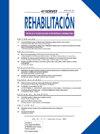使用舌压来确定脊柱侧凸患者的仪器吞咽试验适应症
IF 0.4
Q3 Medicine
引用次数: 0
摘要
在肌萎缩性侧索硬化症(ALS)中,系统的吞咽评估是必不可少的,因为大约85%的患者会出现吞咽困难,其中8%的患者可能会保持临床沉默。虽然存在仪器诊断工具,但它们并不总是可用的。最近的研究表明舌压测量可能对早期发现球功能障碍有价值。本研究旨在建立早期筛查这种功能障碍的舌压分界点。设计:基于前瞻性收集的来自巴塞罗那del Mar医院运动神经元部门脊髓性ALS患者数据的横向研究。材料与方法共纳入58例患者。使用IOPI系统测量前(PA)和后(PP)舌压,并与ALSFRS-R量表一起分析。统计学分析采用描述性统计、Spearman相关、ROC曲线分析(SPSS v25)。结果舌强度与ALSFRS-R评分存在中度相关性(PA: r = .634, P <;措施;PP: r = .539, P <;措施)。识别截止值:PA: 39.5 kPa (AUC = .766;95% ci: 0.700 - 0.831;P & lt;.001),敏感性64.6%,特异性76.4%。PP: 37.0 kPa (AUC = .726;95% ci: 0.653 - 0.799;P & lt;.001),敏感性55.1%,特异性72.2%。结论脊髓性渐冻症患者,全功能与舌压之间存在中度相关性。建议PA = 39.5 kPa、PP = 37.0 kPa作为早期筛查球功能障碍的分界点。本文章由计算机程序翻译,如有差异,请以英文原文为准。
Uso de las presiones linguales para determinar la indicación de estudio instrumentado de deglución en pacientes con ELA espinal
Objective
Systematic swallowing assessment in amyotrophic lateral sclerosis (ALS) is essential, as approximately 85% of patients will develop dysphagia, and 8% of these cases may remain clinically silent. Although instrumental diagnostic tools exist, they are not always accessible. Recent studies suggest that lingual pressure measurements may be valuable for early detection of bulbar dysfunction. This study aims to establish lingual pressure cutoff points for early screening of such dysfunction.
Design
Transversal study based on prospectively collected data from patients with spinal-onset ALS at the Motor Neuron Unit, Hospital del Mar (Barcelona).
Materials and methods
A total of 58 patients were included. Anterior (PA) and posterior (PP) lingual pressures were measured using the IOPI system and analyzed alongside the ALSFRS-R scale. Statistical analysis included descriptive statistics, Spearman correlation, and ROC curve analysis (SPSS v25).
Results
A moderate correlation was found between lingual strength and ALSFRS-R scores (PA: r = .634, P < .001; PP: r = .539, P < .001). Identified cutoff values: PA: 39.5 kPa (AUC = .766; 95% CI: .700-.831; P < .001), sensitivity 64.6%, specificity 76.4%. PP: 37.0 kPa (AUC = .726; 95% CI: .653-.799; P < .001), sensitivity 55.1%, specificity 72.2%.
Conclusion
In spinal-onset ALS, a moderate correlation exists between global functionality and lingual pressures. Cutoff points of PA = 39.5 kPa and PP = 37.0 kPa are proposed for early screening of bulbar dysfunction.
求助全文
通过发布文献求助,成功后即可免费获取论文全文。
去求助
来源期刊

Rehabilitacion
Medicine-Rehabilitation
CiteScore
0.80
自引率
0.00%
发文量
63
期刊介绍:
La revista que es desde hace más de 40 años la publicación oficial de la Sociedad Española de Rehabilitación y referente de la mayoría de las Sociedades de la Especialidad de los países americanos de habla hispana. Se publican 5 números pluritemáticos al año y uno monográfico sobre un tema del mayor interés y actualidad designado por el consejo de redacción.
 求助内容:
求助内容: 应助结果提醒方式:
应助结果提醒方式:


